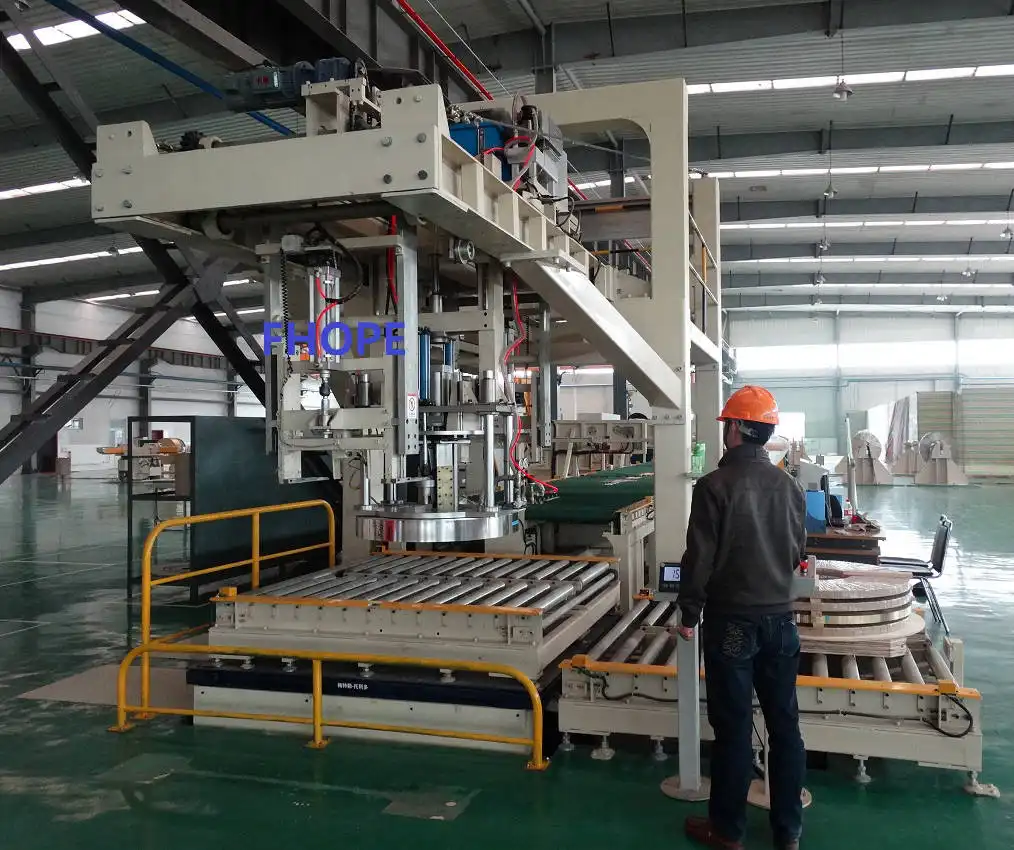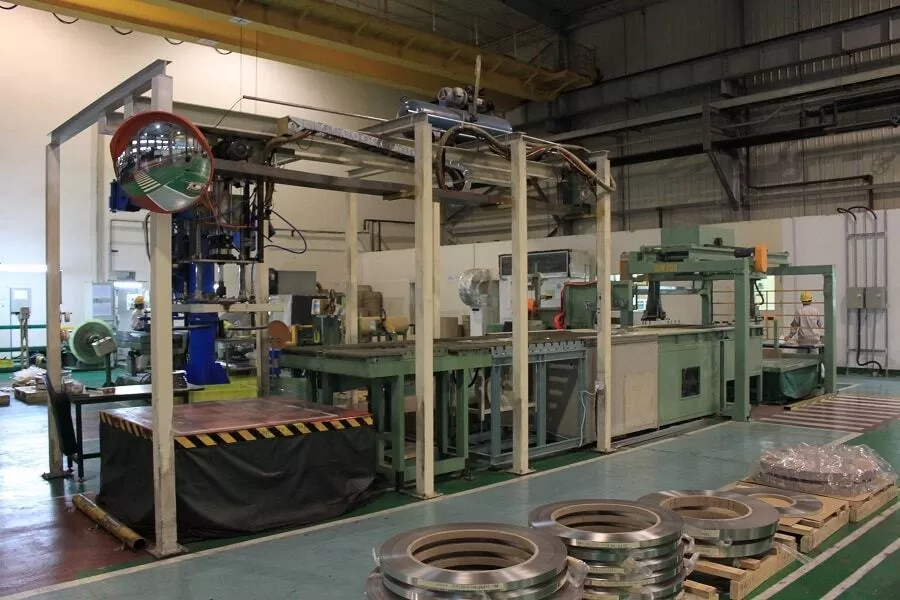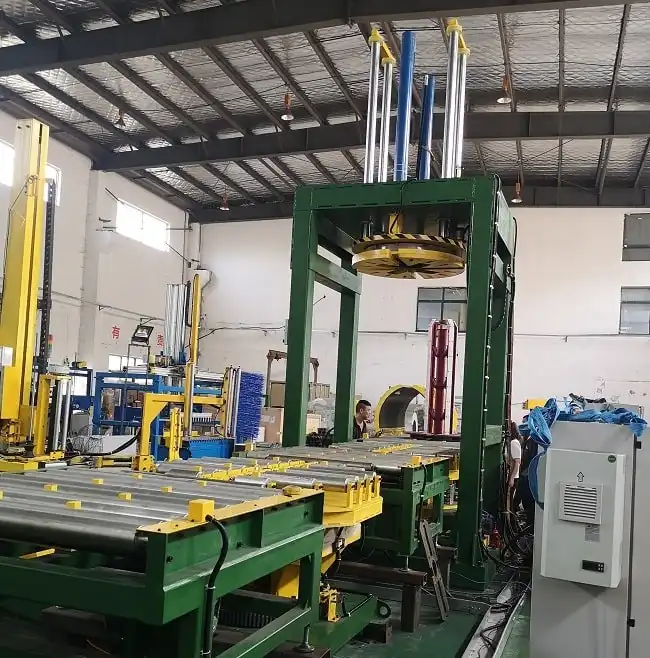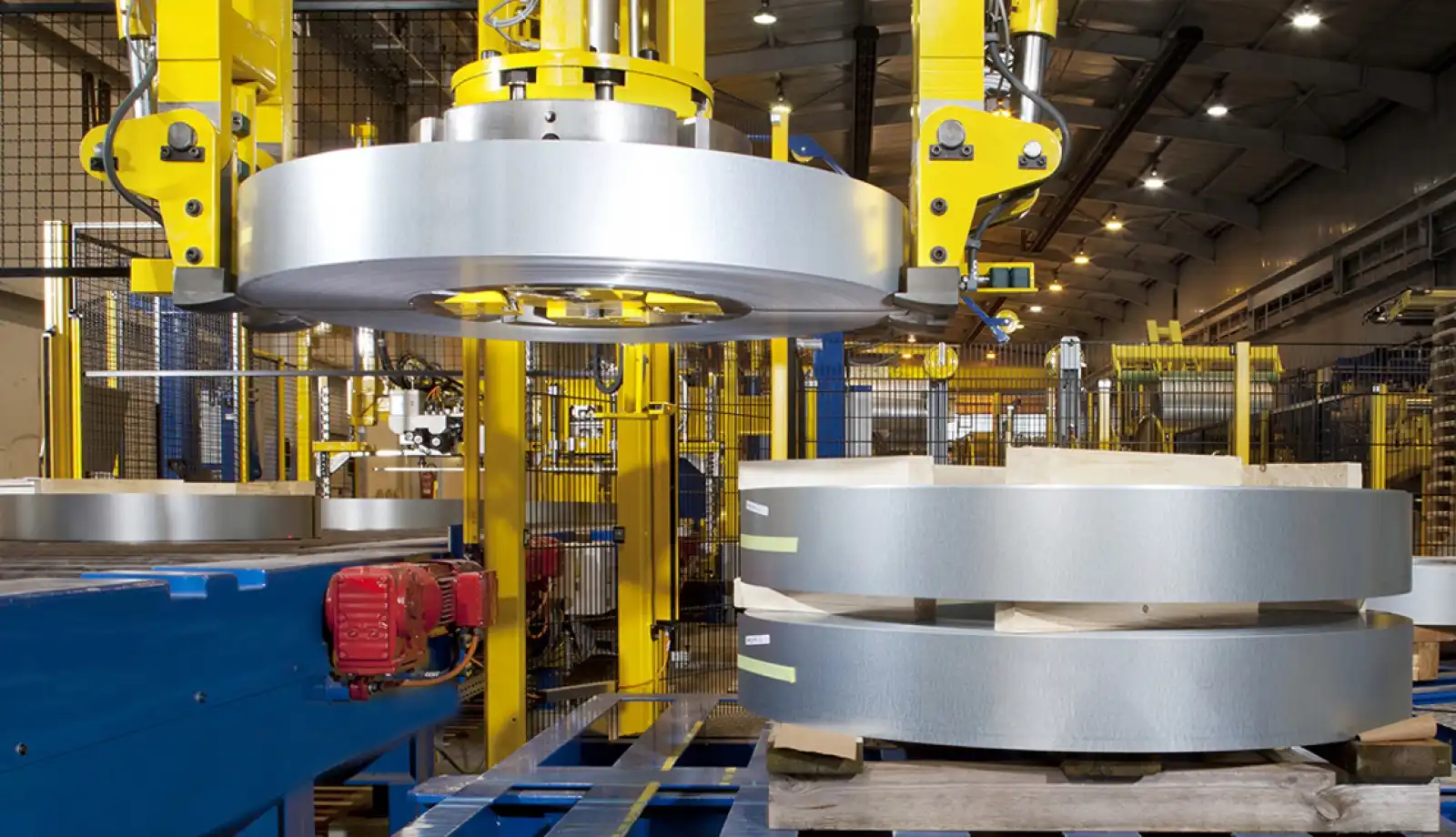The Turkish steel industry is a powerhouse, known for its quality and scale. I know this because I've worked with many clients there. But with great scale comes great pressure. You invest heavily in every stage of production, from the furnace to the rolling mill. Yet, all that effort and investment can be compromised in the final step: packaging. Your valuable steel coils are constantly at risk from moisture, salt in the air, and physical damage during storage and shipping. A single instance of rust or a dent can lead to rejected shipments and damage your hard-won reputation.
A durable, high-speed wrapping solution is the most effective way to protect your steel coils. It works by creating a complete, tightly sealed barrier around the coil using specialized packaging materials like VCI paper or stretch film. This shield protects against the corrosive effects of moisture and the physical hazards of handling and transport. Modern automated systems ensure this protection is applied consistently and quickly, eliminating packaging as a production bottleneck and guaranteeing your steel arrives at your customer's door in the exact same condition it left your mill.

I understand the challenges you face. As an engineer who built his own packing machine factory, I've seen firsthand how a small detail in the final packaging stage can impact the entire business. You aren't just looking for a machine; you are looking for a reliable process that strengthens your operation. You need to know how this investment will impact your bottom line, how it will hold up under the strain of 24/7 production, and how it fits into your vision for a smarter, more efficient factory. Let’s explore these critical questions together.
How can modern wrapping machines reduce operational costs and boost ROI?
You operate in a world of fluctuating energy prices and intense market competition. Every lira spent on your production line needs to justify its existence with a clear return. It’s easy to overlook the packaging station as a major cost center, but it often is. Inefficient machines waste expensive VCI paper or stretch film, require multiple operators per shift, and create production delays that ripple back through your entire line. These are not just minor expenses; they are consistent drains on your profitability. The right wrapping solution is not an expense, but a tool specifically designed to plug these leaks and deliver a strong, measurable Return on Investment (ROI).
Modern wrapping machines directly reduce operational costs and boost ROI by optimizing three key areas: material consumption, labor efficiency, and production throughput. They use precise tension controls and programmable wrapping patterns to apply the exact amount of material needed, cutting waste by up to 30%. Full automation means a single operator can oversee the entire packaging process, freeing up valuable personnel for other tasks. Their high-speed capabilities ensure that packaging never becomes a bottleneck, allowing your production lines to run at their full, profitable capacity.

A Deeper Look at Cost Reduction
When I talk with steel mill owners like yourself, the conversation always comes back to the numbers. You need to see a clear path from investment to profit. Let’s break down exactly where the savings come from when you upgrade to a modern wrapping solution. We're not talking about small changes; we are talking about a fundamental shift in operational efficiency that directly impacts your goal of lowering costs by 8% or more.
From Hidden Costs to Clear Savings
An older or semi-automatic wrapping station has many hidden costs. Material waste is a big one. Without precise controls, operators often use too much film to be "safe," leading to significant overspending over a year. Labor is another factor. You might need two or even three people to manage wrapping, strapping, and moving the coils. This is not an efficient use of your skilled workforce. Finally, there's the cost of downtime and bottlenecks. If your packaging can't keep up with your slitting line, you are effectively slowing down your entire operation.
A modern, fully automatic line addresses each of these points. The PLC control system measures the coil and applies the exact, pre-programmed amount of wrapping material. Automation integrates wrapping, weighing, strapping, and labeling into one seamless flow, often managed by a single technician. High speed means the system can easily handle the output of multiple production lines.
The ROI Calculation: A Practical Example
Let’s look at a simplified comparison to see how the numbers add up.
| Cost Factor | Old Semi-Automatic System (Per Year) | Modern Automatic System (Per Year) | Annual Savings |
|---|---|---|---|
| Labor | 3 Operators x 3 shifts = 9 FTEs | 1 Operator x 3 shifts = 3 FTEs | Cost of 6 FTEs |
| Material (Film/Paper) | ~€150,000 (with 25% waste) | ~€112,500 (waste reduced to <5%) | €37,500 |
| Downtime Costs | High (frequent jams, repairs) | Low (predictive maintenance) | Significant |
| Damage/Rework | 1% of production value | <0.1% of production value | Substantial |
When you add these savings together, the payback period for a new machine is often much shorter than people expect, typically between 18 to 36 months. This calculation doesn't even include the intangible benefits, like improved customer satisfaction from receiving perfectly packaged coils every time. This is how you turn a cost center into a strategic asset.
What makes a wrapping solution truly 'durable' for a 24/7 steel mill environment?
A steel mill is one of the toughest industrial environments on earth. The air can be filled with abrasive dust, temperatures can swing wildly, and the equipment handles immense weight around the clock. Your production cannot stop because of a failure at the packaging station. A breakdown here can cause a catastrophic backlog, halting your entire output. When a machine is down, you are not just paying for repairs; you are losing production, and that is a cost no business can afford.
A truly durable wrapping solution for a 24/7 steel mill is defined by its core engineering and construction. It starts with a heavy-duty, welded steel frame that can absorb vibrations and withstand impacts without twisting or failing. It uses high-quality, globally recognized components, such as Siemens PLCs and SEW-Eurodrive motors, which are known for their reliability and long service life. Every part, from the polyurethane-coated rollers to the oversized bearings, is chosen specifically to resist wear and tear in a demanding, high-cycle environment, ensuring maximum uptime.

The Anatomy of a Machine Built to Last
From my years designing these machines, I can tell you that durability is not an accident. It is a series of deliberate choices. When we build a machine for a steel mill, we are thinking about your reality: running three shifts a day, seven days a week. This thinking influences every component we select and every joint we weld.
Built from the Frame Up
The foundation of any durable machine is its frame. We use thick, structural steel, not bent sheet metal. All joints are fully welded by certified welders and then stress-relieved to prevent warping over time. This creates a rigid, stable platform that ensures all other components stay in perfect alignment, even under the stress of wrapping a 30-ton coil. A weak frame is the primary cause of premature wear on rollers, bearings, and drive systems.
Components That Don't Quit
You know the importance of reliable suppliers for your own business. We feel the same way about our components. That’s why we build our machines around a core of proven, high-quality parts.
| Component | Why It Matters for Durability | Our Approach |
|---|---|---|
| Motors & Gearboxes | The heart of the machine. Failure means total shutdown. | We use brands like SEW-Eurodrive or Siemens. They are known for robust performance and global parts availability. |
| Control System (PLC) | The brain of the machine. A fault can be hard to diagnose. | We standardize on Siemens PLCs. They are incredibly reliable and your maintenance team likely already knows them. |
| Rollers | Constant contact with heavy, abrasive coils. | Our support and conveyor rollers are made from solid steel and coated with thick polyurethane (PU) to protect the coil surface and absorb shock. |
| Bearings | A frequent point of failure in low-quality machines. | We use oversized, sealed bearings from top brands like SKF or FAG to handle heavy radial and axial loads. |
This focus on quality components means the machine runs longer between service intervals and is less likely to suffer an unexpected breakdown. It is an investment in uptime, which is one of the most important metrics in your entire plant. This is the difference between a machine that just works and a machine that works for a decade.
How does high-speed wrapping integrate with digital transformation goals?
You are investing in smart platforms like MES and IoT sensors because you know that data is the key to unlocking the next level of efficiency. You need total visibility of your operations to make intelligent decisions. A packaging machine that operates in isolation is a blind spot in your digital factory. It becomes a data black hole. If you cannot see its performance, measure its material consumption, or track its status in real-time, you cannot optimize it. This lack of integration actively works against your goals of achieving 95% capacity utilization and creating a fully connected plant.
Modern high-speed wrapping solutions are designed to be active nodes within your digital ecosystem. They integrate seamlessly with your factory’s MES (Manufacturing Execution System) and SCADA systems through standard communication protocols like Profinet or Ethernet/IP. The onboard PLC doesn't just run the machine; it acts as a data hub, collecting and transmitting critical information. This data stream includes coils wrapped per hour, material used per coil, cycle times, and detailed diagnostic codes. This transforms your packaging line from an isolated island into a transparent, data-rich contributor to your overall digital transformation strategy.

Turning Your Packaging Line into a Data Source
I remember when the main goal was just to make a machine run fast. Now, the goal is to make it run smart. A smart machine communicates. It provides the information you need to manage your entire production flow more effectively. For a leader like you, who is focused on data-driven improvements, this is not a luxury; it is a necessity.
The Data That Drives Decisions
A modern wrapping machine can provide a wealth of information directly to your central control systems. Think about what you could do with this data:
- Real-Time Production Monitoring: Your production dashboard can show the live status of the packaging line, including its current speed and the number of coils completed in the last hour or shift.
- Accurate Costing: By tracking the exact amount of wrapping film and paper used for each specific coil, you can calculate the precise packaging cost per product. This data is invaluable for financial analysis and pricing strategies.
- Efficiency Analysis: The machine's PLC logs every stop, start, and fault. By analyzing this data, you can identify patterns. Maybe a specific type of coil is causing slowdowns, or a sensor is starting to fail. This allows you to fix small problems before they become big ones.
Enabling Predictive Maintenance and Smart Scheduling
This is where integration becomes truly powerful.
- Predictive Maintenance: We can equip the machine with IoT sensors to monitor the health of critical components. For example, a vibration sensor on the main ring gear or a temperature sensor on a motor can detect early signs of wear. This data is sent to your maintenance system, which can automatically schedule a service check before a failure occurs. This is the key to moving from reactive repairs to a proactive, predictive maintenance model, which is a core part of your goal to boost uptime.
- Smart Scheduling: When your MES knows the real-time status and capacity of your packaging line, it can schedule production more intelligently. If the MES knows that the packaging line can handle 20 coils per hour, it won't allow the slitting lines to send 25 coils per hour. This prevents backlogs and ensures a smooth, continuous flow of production throughout the plant, helping you reach that 95% utilization target.
What level of support should you expect from a strategic packaging partner?
Making a significant capital investment is about more than just the hardware. You've experienced it before: a supplier makes big promises, delivers the machine, and then is difficult to reach when you need support. This leaves your team scrambling to solve problems, find spare parts, and optimize a machine they didn't design. This is not a partnership; it is a transaction, and it exposes your operation to unnecessary risk. You are not just buying a machine; you are investing in a long-term production capability, and that requires a partner who is just as invested in your success as you are.
A true strategic partner provides comprehensive, end-to-end support that covers the entire lifecycle of the equipment. This begins long before the purchase order, with a deep consultation to understand your specific needs in the Turkish market. It continues with professional, on-site installation and commissioning by their own engineers. Crucially, it includes thorough training for your operators and maintenance staff. And for years after, it means having a direct line for technical support, a reliable supply of spare parts, and proactive advice to ensure your machine continues to deliver maximum value. They become an extension of your engineering team.

The Difference Between a Supplier and a Partner
I built my company, SHJLPACK, on the principle of partnership. When I was running my own factory, I learned that the support you get after the sale is what really determines the value of an investment. A good machine from a bad partner is a bad investment. Here is what you should demand from any company you consider a strategic partner.
Phase 1: Before the Sale - The Right Solution
A partner doesn't start by sending you a catalog. They start by asking questions.
- Needs Analysis: They should want to understand your coil dimensions (ID, OD, width, weight), your production rate, your packaging material specifications, and your factory layout.
- Customization: The Turkish market has its own requirements. A partner will work with you to tailor the solution. This could mean designing a specific conveyor layout to fit your space or modifying the control system to integrate with your existing MES.
- Clear Proposal: The proposal should be detailed, transparent, and explain why they are recommending a certain solution.
Phase 2: During Installation - A Smooth Start
This phase is critical. A partner doesn't just ship a crate to your door.
- On-Site Engineers: The manufacturer's own qualified engineers should be on-site to supervise the installation, commissioning, and testing. They know the machine better than anyone.
- Comprehensive Training: They must provide hands-on training for both your operators (on how to run the machine efficiently) and your maintenance team (on how to service and troubleshoot it). This empowers your own people.
Phase 3: After the Sale - Long-Term Success
The relationship truly begins after the machine is running.
- Accessible Support: You need a direct line to technical experts who can help you solve problems quickly, often through remote diagnostics.
- Spare Parts: A partner should maintain a stock of critical spare parts and be able to ship them to Turkey quickly to minimize downtime.
- Proactive Engagement: A great partner will check in with you, offer advice on new materials or software upgrades, and help you continue to optimize the machine's performance as your business grows. This is the definition of a "Total Solution."
My Insight
I read your profile, and in many ways, it reminds me of my own journey. I also started as an engineer on the factory floor. I learned how these machines work, what makes them fail, and the pressure that operators and managers are under every single day. When I finally started my own factory, I faced the same challenges you do now: controlling costs, pushing for more efficiency, and making big investment decisions that I knew would define my company's future.
I remember the feeling of signing a check for a major piece of equipment. It wasn't just about the money. It was about trusting that the machine would perform as promised and that the supplier would be there to support me if things went wrong. Frankly, I was sometimes disappointed. I found that many sellers were interested in the sale, but not in my success.
That experience is the entire reason I founded SHJLPACK with the mission we have today. I didn't want to be just another equipment supplier. I wanted to be the partner that I wish I had back then. My goal is not to just sell you a wrapping machine. My goal is to share the knowledge I gained over 25 years to help you find the right solution for your mill in Turkey. We succeed only when you succeed, when your coils are protected, your costs are down, and your factory is running more smoothly than ever before. This is my commitment.
Conclusion
Choosing the right wrapping solution is a strategic decision. It protects your product, reduces your operational costs, and directly supports your long-term growth and digital transformation in the competitive Turkish market.





